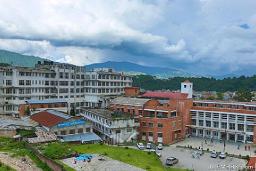


Studying MBBS in Nepal has become a popular alternative for Indian students who face high competition and expensive tuition fees in India. Both Nepal and India offer quality medical education, but there are clear differences in cost, admission process, duration, recognition, and post-graduation opportunities. For many Indian aspirants who cannot secure a government medical seat in India, Nepal provides a more affordable and accessible pathway while maintaining academic standards similar to the Indian curriculum.
This article provides a detailed comparison of MBBS in Nepal vs MBBS in India, covering essential aspects such as fees, eligibility, course duration, recognition, clinical training, and living costs.
One of the biggest deciding factors for medical aspirants is the cost of education.
MBBS Fees in India:
Government medical colleges in India charge anywhere between INR 1–5 lakhs per year, but admission is highly competitive due to limited seats.
Private medical colleges in India can charge INR 15–25 lakhs per year, with total costs going above INR 80 lakhs to 1 crore.
MBBS Fees in Nepal:
Tuition fees in Nepal are much lower, averaging INR 8–12 lakhs per year.
The total cost of the entire MBBS course is around INR 40–60 lakhs, which is significantly more affordable compared to Indian private colleges.
Verdict: For Indian students who cannot secure a government seat, Nepal offers a much more affordable option without compromising the quality of education.
In India: MBBS duration is 5.5 years, which includes 4.5 years of academic study and 1 year of compulsory internship in recognized hospitals.
In Nepal: MBBS duration is also 5.5 years, with 4.5 years of theoretical and practical learning followed by 1 year of internship.
Both countries follow a similar course structure, ensuring students cover all the required subjects such as Anatomy, Physiology, Pathology, Pharmacology, Medicine, Surgery, and Pediatrics.
Verdict: Course duration is the same in both countries, making Nepal a seamless alternative for Indian students.
India:
Admission to MBBS in India requires qualifying NEET-UG with a high score due to intense competition.
Government seats are limited, and most students struggle to get admission despite qualifying.
Private colleges often have management or donation seats, making it financially challenging.
Nepal:
Indian students must also qualify NEET-UG, but the cut-off marks required for admission in Nepal are much lower than India.
The process of MBBS admission is straightforward with transparent seat allocation.
Students are not required to pay hefty donations for admission.
Verdict: Nepal offers a more accessible admission pathway for Indian students compared to the highly competitive Indian system.
India: MBBS degrees from Indian medical colleges are automatically recognized by the National Medical Commission (NMC). Graduates can practice in India after completing their internship and registering with state medical councils.
Nepal: MBBS degrees from NMC-approved Nepalese universities are recognized by NMC (India), WHO, WDOMS, FAIMER, and other global medical councils. This recognition allows graduates to practice in India after clearing FMGE/NExT, or pursue careers abroad by qualifying exams like USMLE (USA) or PLAB (UK).
Verdict: MBBS degrees from both Nepal and India are globally recognized, but Nepalese graduates must clear licensing exams in India.
In India: Students in government medical colleges get extensive clinical exposure due to a large patient inflow in public hospitals. However, in private colleges, clinical exposure can sometimes be limited.
In Nepal: Students gain hands-on training in teaching hospitals affiliated with their universities. Many of these hospitals follow the same clinical protocols as India, and patients are diverse due to Nepal’s multicultural population. Clinical exposure is excellent, especially in cities like Kathmandu and Pokhara.
Verdict: Both India and Nepal provide strong clinical exposure, but government colleges in India still offer a larger patient base compared to Nepal.
In India: The cost of living for medical students depends on the city. On average, hostel and living expenses can range from INR 8,000–15,000 per month.
In Nepal: The cost of living is slightly lower compared to Indian metro cities. Hostel charges are around USD 100–150 per month (INR 8,000–12,000). Indian students also get access to Indian food and cultural familiarity, making adaptation easy.
Verdict: Living in Nepal is cost-effective and culturally comfortable for Indian students.
Affordable Fees – Significantly lower than Indian private colleges.
Proximity to India – Easy travel and cultural similarities.
Indian Curriculum – Many universities follow similar teaching methods as in India.
No Donation – Admission is merit-based and transparent.
English Medium – Most MBBS programs are taught in English.
Global Recognition – Degrees are valid in India, USA, UK, and other countries.
After MBBS in India: Graduates can directly apply for PG programs in India, practice after registration, or appear for global licensing exams.
After MBBS in Nepal: Indian students must pass FMGE/NExT to practice in India. They can also apply for PG studies in India or abroad.
Verdict: Career opportunities are strong in both cases, but students from Nepal need to clear an additional exam for Indian practice.
| Factor | MBBS in India | MBBS in Nepal |
|---|---|---|
| Course Duration | 5.5 years (incl. internship) | 5.5 years (incl. internship) |
| Tuition Fees | Govt: INR 1–5 lakhs/year; Pvt: 15–25L | INR 8–12 lakhs/year |
| Total Cost | Govt: INR 10–30 lakhs; Pvt: 80L–1 Cr | INR 40–60 lakhs |
| NEET Requirement | Mandatory, very high cutoff | Mandatory, lower cutoff |
| Recognition | NMC, WHO, WDOMS, Global | NMC, WHO, WDOMS, FAIMER, Global |
| Clinical Exposure | High in govt. colleges, moderate in pvt | Strong exposure in teaching hospitals |
| Living Costs | INR 8k–15k per month | INR 8k–12k per month |
| Career Path | Direct registration in India | FMGE/NExT required for India |
While MBBS in India remains the dream for many, the limited seats and skyrocketing costs of private colleges force students to explore alternatives. In this context, MBBS in Nepal emerges as a smarter choice. It offers affordable fees, globally recognized degrees, cultural comfort, and quality medical education that closely matches the Indian system.
For Indian students who want to pursue medicine without spending crores on private colleges, Nepal provides an ideal balance of cost, quality, and accessibility. With proper guidance, admission support, and exam preparation for NExT, studying MBBS in Nepal can open the doors to a rewarding medical career in India and worldwide.
| No comments yet. Be the first. |